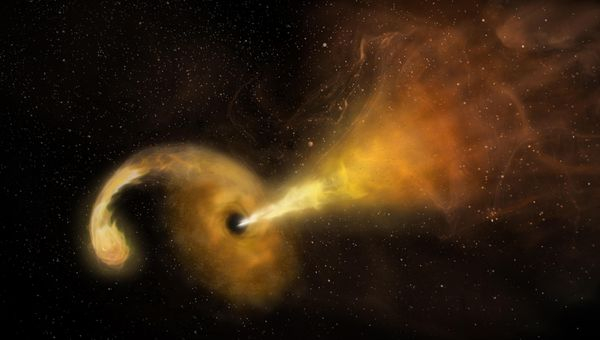Humans could use black holes as batteries, physics paper claims. Here's how.
Black holes are some of the most powerful objects in the universe — and humans could devise ways to harness that power as an energy source, a new theoretical study claims.

The gravitational pull from black holes is so strong that nothing can escape its grasp. So could we ever harness the gargantuan power of black holes as a source of energy?
In a new study, scientists propose two ways to use black holes as energy sources someday. They predicted processes for extracting energy from black holes by using their rotational and gravitational properties.
"We know that we can extract energies from black holes, and we also know that we can inject energy into them, which almost sounds like a battery," lead author Zhan Feng Mai, a postdoctoral researcher at the Kavli Institute for Astronomy and Astrophysics at Peking University, told Live Science.
In the first hypothetical scenario, scientists would "charge" the black hole by injecting it with massive, electrically charged particles. These charges would continue being sucked in until the black hole itself had an electric field that began repelling any additional charges that they attempted to inject, the scientists explained in the study, published Nov. 29 in the journal Physical Review D.
When this electromagnetic repulsion was greater than the gravitational pull of the black hole, scientists would consider it "fully charged." In keeping with Einstein's theory of general relativity, which says that mass can be treated as equivalent to energy, the black hole’s available energy would come from a combination of the electrical charges injected into it as well as the mass of those electrical charges.
"The black hole battery is transforming the energy of the particle's mass into charge energy," Mai said.
Get the Space.com Newsletter
Breaking space news, the latest updates on rocket launches, skywatching events and more!
The researchers calculated the efficiency of the recharging process to be 25%, meaning that black hole batteries could transform about a quarter of the mass inputted into available energy in the form of an electric field. This would make the efficiency of the battery around 250 times higher than that of an atomic bomb, the team calculated.
To extract the energy, the researchers would utilize a process known as superradiance, which is based on the theory that space-time is literally dragged around the rotation of a spinning black hole because of its intense gravitational field.
Gravitational or electromagnetic waves that entered this region of rotation would get dragged along too, but assuming they had not yet passed the black hole's event horizon — the boundary beyond which nothing, not even light, can escape — some waves might be deflected with more energy than they initially carried, the researchers wrote. This process would convert the black hole's rotational energy, determined by its mass, into the waves that are deflected.
The other method of harnessing a black holes' energy would involve extracting that energy in the form of so-called Schwinger pairs, or paired particles that form spontaneously in the presence of an electric field.
If we started with a fully charged black hole, the electric field near the event horizon might be so strong that it would spontaneously create an electron and positron, which is like an electron but with an opposite charge, Mai explained. If the black hole were positively charged, the positron would be shot out from the black hole due to repulsion. That runaway particle could then, theoretically, be collected as energy.
Mai said he does not know if we will ever see a battery like this, but the theoretical exercise was inspired by scientists' previous attempts to theoretically extract energy from black holes.
"We see the black hole as a place where quantum mechanics and gravity have to somehow get together," Daniele Faccio, a physicist at the University of Glasgow who was not involved in the study, told Live Science. "By looking at them from the perspective of energy mining, we can understand a little more about what's going on."
Join our Space Forums to keep talking space on the latest missions, night sky and more! And if you have a news tip, correction or comment, let us know at: community@space.com.

Jacklin Kwan is a freelance journalist based in the United Kingdom who primarily covers science and technology stories. She graduated with a master's degree in physics from the University of Manchester, and received a Gold-Standard NCTJ diploma in Multimedia Journalism in 2021. Jacklin has written for Wired UK, Current Affairs and Science for the People.
NASA spacecraft spots monster black hole bursting with X-rays 'releasing a hundred times more energy than we have seen elsewhere'
Could we use black holes to power future human civilizations? 'There is no limitation to extracting the enormous energy from a rotating black hole'
-
steve_foston A similar idea has actually already been mooted as the power source of the Tardis in the BBC Dr Who series maybe they are onto something - we just need the Time Lord technology to be able to use it.Reply










